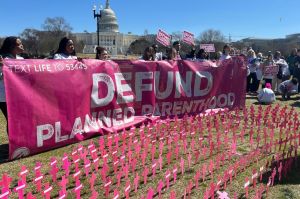Willow Creek restructuring draws ire at one campus, most staff resign

Willow Creek Community Church leaders are facing backlash from staff and members at one of its campuses over restructuring plans that include centralization and staff cuts.
Dozens of staff, some who have been serving for over a decade, as well as the campus pastor at North Shore in Glenview, Illinois, have already chosen to leave.
“If you left right now before you experienced the [new] model, that wouldn’t be the most informed decision,” said Willow Creek’s new senior pastor, Dave Dummitt, in a meeting last month with concerned North Shore church members. “I think Satan would be pretty pleased with that.”
The Illinois megachurch, which has eight locations, has been reeling since the 2018 resignation of longtime pastor and founder Bill Hybels, who was accused by multiple women of sexual misconduct. Dummitt, who was named earlier this year to lead the church, recently presented a new vision for the church’s future. Part of that vision includes eliminating some staff positions and restructuring roles, what the church called “right-sizing.”
The church contended that its ratio of staff to congregation was 1:57, “nearly twice as many staff as other similar churches.”
“With a two-year slide in finances across nearly all campuses, this puts a strain on our ability to do ministry. As attendance dropped at almost every campus, these ratios were getting worse, not better,” the church said.
According to The Roys Report, Willow Creek’s central leadership team eliminated 92 positions across the church’s eight campuses. The cuts hit the North Shore campus especially hard, with 13 staff resigning. Of the remaining staff, 14 took a buyout, leaving behind only five staff members to lead the campus of over 2,600. Those who left included North Shore’s popular lead pastor, Amy Mikal, who had been asked to move into a different role.
Willow Creek said of Mikal, “She is passionate about teaching and preaching, and as she has been able to do that more, her passion has grown. Amy does not feel that the new job description fits her passions and strengths.”
A new pastor, Ed Ollie Jr., was hired to lead North Shore, the church announced last week.
North Shore members, who felt their campus was thriving, said they felt concern over the sudden changes and dependence on Willow Creek’s central leadership.
Former Willow Creek staff member Steve Higgins posted a video of a dialogue the church held last month with North Shore members, many of whom said they didn’t trust the church’s central leaders with financial or moral responsibility.
“Unfortunately, I can’t trust you guys,” said Cliff Nelson, a founding member of the North Shore campus. “If you’re in favor of standing in solidarity with our church staff, rejecting this strategy and to begin to pursue withdrawal of this church, I would ask you to stand, turn on your [car] lights.”
North Shore members responded by clapping loudly, flashing car lights and honking their horns.
Many North Shore members are in the middle of 40 days of fasting and prayer to decide whether to split or remain with the church, according to The Roys Report. The 40 days will end on Nov. 22.
Dummitt responded to the rising calls for a North Shore split from Willow Creek by telling a story. While working at a church in Cincinnati, he ran a highly successful ministry that functioned like a church within the church, he said. When his ministry grew faster and brought in more money than the church it was part of, many people considered making it into its own church. He opposed a split.
“I felt called to be a church planter but not a church splitter. I just didn’t think God would bless it. Now, y’all are able to do whatever,” he said. “You vote with your feet and your pocketbook. I don’t have any power over you.”
Dummitt stressed during the dialogue that he wasn’t trying to write off North Shore’s vision or what it has accomplished but rather the new vision is that they can all do better “together.”
As an “outsider,” Dummitt said he felt Willow Creek was a “very divided church.” It’s divided over “how leadership handled the last two years,” over how to respond to racial issues, and all of its campuses have different visions, systems and cultures, he noted.
Addressing concerns about centralization, the church said the executive team it is building will be comprised of 18 people, only one of whom will be a staff member from the South Barrington campus, which has been known as the main campus.
Huntley campus Lead Pastor Todd Katter also noted, “Someone called me last week from North Shore and said, ‘The greatest potential for abuse of power is no longer Willow central because it’s got a lot of eyes on it. It’s Willow campuses.’”
In a statement to The Christian Post, Willow Creek addressed the controversy, stating:
"The model we are moving toward is all about collaboration, support, and unity. Emerging from a season where abuse of power occurred, this aligned model also provides more accountability at every level. It will empower our campus staff to pastor, serve, and shepherd while removing redundant and administrative tasks; it will create bigger tables for brainstorming and conversation by pulling together similar positions from all campuses; and it will allow us to multiply teams and churches more efficiently and effectively.”
The church said “caring for the staff and congregation at North Shore is a top priority for us” and acknowledged the challenges that change brings and how it has impacted staff. But they are “trusting that some of the changes we are making, though hard, will lead to a healthy, sustainable, and growing church.”
“Ultimately, our desire is for people to know Christ, grow deeper in their relationships with Him, and lead others into relationships with Him. We want people to be in a church where they are connected and are growing in their faith—that doesn't have to be Willow. There’s a beauty in the vastness of churches that exist, but our prayer is that at the end of the day, we can all represent one Body of Christ to our neighbors and world.”
The megachurch, which is not resuming large in-person gatherings beyond 25% seating capacity until 2021, has clarified that it is not currently struggling financially. While giving is “down partially as a result of people leaving the church over the past two years due to the scandal” and due to the impact of the COVID-19 pandemic, costs are also down due to buildings being closed during the pandemic.
“All our campuses will end the year in the black. Today isn’t the problem. It’s the trajectory that is concerning,” the church stated. “Staffing costs are the biggest portion of our budget at each campus, and without some changes, facing similar expenses in 2021 with considerably less revenue would result in significant challenges.”
In 2017, Willow Creek received $89.2 million in revenue to pay $77.6 million in expenses, according to the Evangelical Council for Financial Accountability. In 2019, the church received $62.9 million to pay for $64.9 million in expenses. Willow Creek's 2020 budget has not yet been released.





























